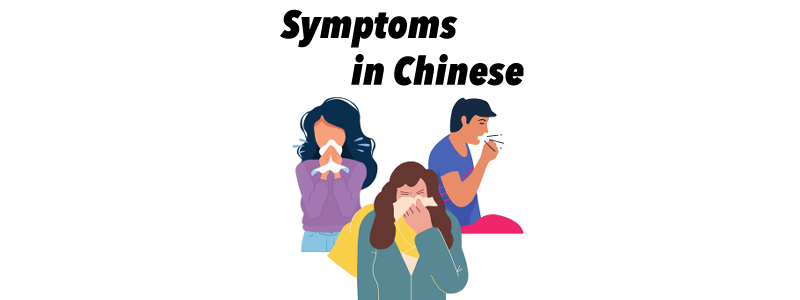Looking at symptoms alone seems a bit boring, so let’s dive into various symptoms along with some basic knowledge of Traditional Chinese Medicine!
Sick – 生病 shēngbìng
Ache:
Traditional medicine believes that the primary reasons for ache are as follows: firstly, “no flow leads to pain,” and secondly, “lack of nourishment leads to pain.” “No flow” refers to the blockage of the body’s meridians, which hinders smooth circulation and sends out signals of “pain.” “Lack of nourishment” means that the body’s organs do not receive proper nutrition, resulting in signals of “pain.”
Treatment methods include:
- Tui Na, Massage, and Myofascial Techniques (推拿 tuīná): These methods primarily focus on relaxing muscles and promoting flexibility. They help alleviate stiffness, fibrosis, and reduce pain and fatigue.
- Acupuncture (针灸 zhēnjiǔ): Acupuncture involves needling specific points, including those that are tender or painful (“ashi points”). The principle is often “treat where it hurts.” Acupuncture can also target meridians associated with the painful areas. If the pain persists, moxibustion can be added to improve circulation and provide warmth. Modern research shows that acupuncture can improve circulation, increase endorphins (natural painkillers), and inhibit pain signal transmission.
- Internal Chinese Herbal Medicine: This approach involves taking herbal formulations to adjust one’s constitution, improve blood circulation, and strengthen muscles and bones. Common prescriptions include Duhuo Jisheng Tang, Danggui Nian Tong Tang, Simiao San, Shaoyao Gancao Tang, Gegen Tang, and Shujing Huoxue Tang. These formulations typically focus on promoting Qi flow, invigorating blood circulation, and unblocking meridians.
- Herbal Fumigation: This method combines the benefits of traditional Chinese herbal remedies and heat therapy. It can enhance muscle circulation and alleviate pain.
- Headache:頭疼 tóuténg
- Stomachache:胃痛 wèitòng
- Toothache:牙痛 yátòng
- Menstrual cramp:生理痛 shēnglǐ tòng or 经痛 jīngtòng
- Body aches:身体痠痛 shēntǐ suāntòng
Nose and Throat:
All medicines, as well as foods, need to be digested and absorbed by the body to be effectively utilized. Therefore, it’s important to consult with a healthcare professional before using any medication.
Early Stage of Coughing: When you have a sore throat, fever, thick yellow phlegm, you can consider consuming tofu and pear juice. Herbal teas made with ingredients like Penglaihai, Luo Han Guo, winter melon seeds, and jie geng can also be consumed frequently.
Later Stage of Coughing: If you have a dry and itchy throat with less phlegm, you can try stewing Asian pears with rock sugar or consuming fresh lily bulbs, white fungus, and lotus seeds in a soup to nourish yin, moisten dryness, and resolve phlegm.
Note for those with excessive phlegm and severe coughing: Avoid oily, sweet, spicy, and fried foods.
- Stuffy nose: 鼻塞 bísè
- Runny nose:流鼻涕 liúbítì or 流鼻水 liú bíshuǐ
- Sneeze:打喷嚏 dǎpēntì
- Sore throat:嗓子疼 sǎngzi téng
- Cough:咳嗽 késòu
- Asthma:气喘 qìchuǎn
Stomach:
In Traditional Chinese Medicine (TCM), it is believed that a person’s emotions can affect their “Liver Qi.” According to TCM’s Five Elements theory, the Liver is associated with Wood, while the Stomach and Spleen are associated with Earth. When emotions are unsettled, it can disrupt the flow of Liver Qi, which may then affect the Earth element, leading to digestive issues. Therefore, maintaining a pleasant mood during meals and ensuring good sleep can help improve digestion.
For gastrointestinal health, it is recommended to consume foods and herbs that support spleen and stomach health, remove dampness, and promote drainage. For example, adding ginger, especially the ginger peel, to your cooking can be beneficial. Additionally, foods like pork, lean meats, barley, sweet potatoes, and yams can be included in your diet. Drinking a bowl of sweet potato soup in the morning can significantly improve your overall well-being.
- Vomit:嘔吐 ǒutù
- Diarrhea:闹肚子 nào dùzi or 腹泻 fùxiè
- Nauseous:恶心 ěxīn
- Constipation:便秘 biànmì
- No appetite:没食欲 méi shíyù
Others:
Muscle cramps are often caused by “Liver Blood deficiency,” leading to insufficient nourishment of the muscles and resulting in cramping. You can improve this condition through the following methods:
- Chinese Herbal Medicine: Consult a traditional Chinese medicine practitioner to tailor herbal remedies based on your individual body condition. This approach tends to be more effective.
- Acupuncture Treatment: Acupuncture can effectively regulate muscle excitability, unblock meridians, promote Qi circulation, and alleviate discomfort after muscle cramps.
- Acupressure: Apply pressure to specific acupoints for relief. The “Chengshan” acupoint, located in the middle of the back of the calf, is especially useful during a cramp. Regular maintenance can include pressure on the “Yanglingquan” acupoint located on the outer side of the lower leg, just below the fibula head, known for its effectiveness in treating muscle issues.
- Warm Foot Soaks: Use a warm towel or electric blanket on the area prone to cramps, ensuring the temperature is not too high. For foot soaks, adjust the water temperature to around 40 degrees Celsius and soak your feet, making sure the water level is at least three inches above the ankles. Regular foot soaks help improve blood circulation, reduce nighttime cramps, and promote better sleep.
- Cramp:抽筋 chōujīn
- Allergic:过敏 guòmǐn
- Sweating:出汗 chūhàn
- Rash:皮疹 pízhěn
- Chill:发冷 fālěng
- Dizzy:头晕 tóuyūn
- Fever:发烧 fāshāo


